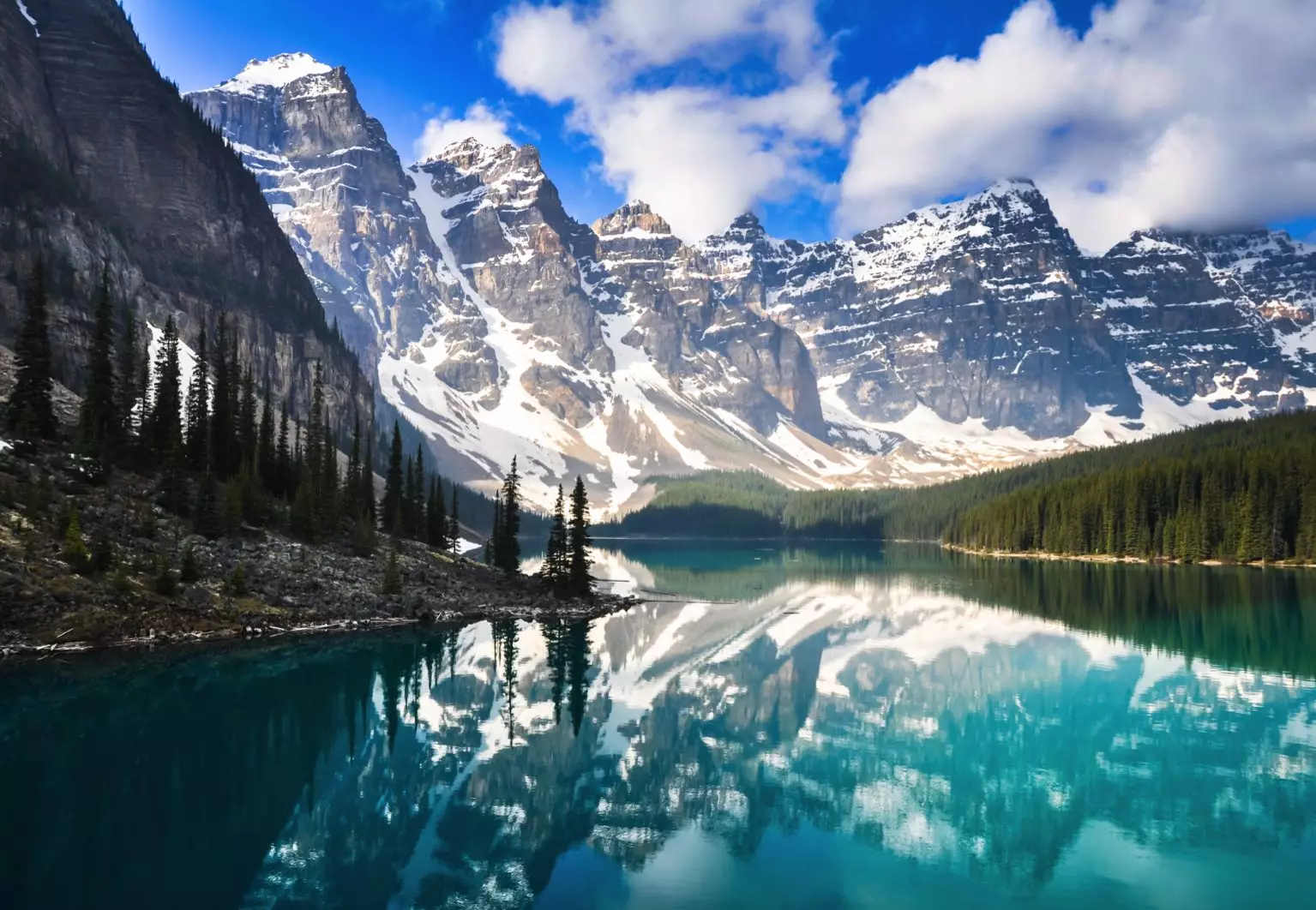The Formation of Canada’s Lakes
Canada contains more than 2 million lakes of all sizes. Each Canadian lake brings its share of surprises. Some of them are isolated enough to be accessible only by hiking the dense trails through the jungle. These blue and green hued bodies of water are often surrounded by lush forests and rugged mountains.

How to explain this impressive number of lakes in the country? Its territory has contained numerous glaciers which have sunk several tens – even hundreds – of meters into the ground, forming the beds of a multitude of lakes. With the gradual melting, massive floods of water were released. Combined with the weight of the glaciers and the digging of the glaciers, all this created a cluster of lakes on the ground of what is now Canada. To this day, this terrain continues to rise in response to these events. At the scale of the Earth, the melting of glaciers and the formation of these lakes date from not so long ago.
Moreover, the origin of the waters of the Canadian lakes had another consequence. You have probably noticed the blue-green colors of Canada’s waters. Have you ever wondered where those azure hues come from? It is indeed because this water comes from glaciers. Over time, they reduced the rock walls to a very fine powder. By floating in the water and on its surface, it reflects all the light around them which creates these magnificent colors.
The Great Lakes System of North America
In North America, there is a network of 5 interconnected lakes. These are lakes Erie, Superior, Huron, Ontario and Michigan. All are located around the central-eastern border of Canada and the United States and the first four are shared between the 2 countries. Only Lake Michigan is entirely within the United States.
Between them 5, they contain nearly 21% of the world’s surface fresh water, or 22,684 km³ of water. In terms of area, the largest is Lake Superior, which is also the northernmost of them all. This is followed by Lake Huron at the center of the network, Lake Michigan and Lake Erie. Finally, the smallest is Lake Ontario.
These 5 interconnected lakes feed the Canadian St. Lawrence River – which in turn empties into the Atlantic – and the American Mississippi – which then joins the Gulf of Mexico. The Great Lakes network thus played a critical role in river communication, as evidenced today by the St. Lawrence Seaway.
Several cities and metropolises are located on the basin of the Great Lakes of North America. They also border Ontario and eight US states. The cross-border area called Main Street America includes several densely populated cities. These are Chicago, Detroit, Cleveland, Milwaukee or even Toronto.
There is a highway that bypasses the four Great Lakes on Canadian territory. If you are passing through and are planning a roadtrip in the country, take it to see these exceptional natural lakes.
Canada’s largest lakes
Lake Superior is the largest lake in Canada, with an area of 82,100 km². It contains 10% of the world’s fresh surface waters and it is the 2nd largest lake in the world after the Caspian Sea. Note, however, that part of Lake Superior is located in the United States.
Lake Huron covers 59,600 km² and is formed by 4 interconnected bodies of water: the main lake, Saginaw Bay, the North Channel and Georgia Bay. In the Lake Huron archipelago, Manitoulin Island is home to 6 First Nations tribes.
With its 31,328 km² in area, Great Bear Lake is the largest entirely located lake in Canada. It is located on the Arctic Circle, in the boreal forest of the Northwest Territories. It is home to the largest lake trout in the world.
Great Slave Lake is also entirely within Canada in the Northwest Territories. It is 28,568 km² in area and is the deepest lake in North America.
The other most famous lakes
Canadian lakes attract millions of tourists every year, and some are much more visited than others. In the West, the lakes of Alberta and British Columbia are extremely beautiful. However, if you are looking to swim or go motor boating, you will rather go east.
Emerald Lake is located within Yoho Park in Western Canada. It owes its emerald color to the glaciers from which its water comes. Over time, these have released limestone. These mineral fragments present in the water then reflect all the light around them. It’s a beautiful landscape, especially in the height of summer (July) with the Canadian Rockies all around. This well-known lake is accessible all year round.
Moraine Lake in Banff Park – Alberta in the Canadian Rockies – is considered by many to be the most beautiful lake in the country. On windless days, its smooth surface turns into a real mirror. Like most Canadian lakes, it is fed by melting glaciers and its azure waters are particularly beautiful. Attention! Its beautiful clear waters are freezing. Swimming in Moraine Lake unprepared and without a wetsuit is very dangerous, even in the height of summer.
Lake Garibaldi, in the park of the same name in British Columbia, is an alpine lake. It is bordered by mountains on one side and volcanoes on the other, against a backdrop of glaciers. It is only accessible on foot via a 6 to 8 hour hike through meadows and mountains. For many people, the landscape of the lake and its surroundings more than justifies the effort.
Other very unique lakes are also widely visited. Lake Abraham – in Alberta – is an artificial lake that was created following the construction of a dam in 1972. When its water freezes, bubbles of methane are captured and frozen under its surface. It is a striking spectacle that attracts the bravest curious in winter. Methane is generated by decaying plants at the bottom of the lake.
Spotted Lake in south-central British Columbia features a multitude of spots formed by mineral deposits. It offers an amazing picture in summer, when these deposits harden in the sun and glow with color. Spotted Lake is owned by the Syilx Okanagan First Nations people. They also consider it a sacred and healing lake.
News
Brad Pitt’s Unfortunate News. The Legendary Actor Himself Made The Announcement
Brad Pitt has informed his followers about his latest health condition. The well-known actor has shown that he has a problem with identifying people’s faces. He suspects…
(N) Solange Breaks Silence: Jay Z’s Shocking Ban on Beyonce’s Communication with Her Revealed
In a recent interview, Solange Knowles, sister of pop icon Beyoncé, has divulged details about Jay Z, Beyoncé’s husband, allegedly prohibiting her from speaking to her own…
(N) Shocking Lawsuits: Jaguar Wright Exposes Jay-Z And Beyoncé’s Hidden Truths
Jaguar Wright is revealing explosive allegations against Jay-Z and Beyoncé. Find out why they could be facing lawsuits and learn more about the shocking claims in this…
(N) Warwick Davis brings his wife Samantha and children to the screening of Disney+ series Willow as he reprises his role 34 years on
Warwick Davis is reprising his role as Willow Ufgood 34 years on for a new Disney+ series. And the actor, 52, brought his wife Samantha, 51, along with his daughter…
(N) BLUE IVY runs to her BOYFRIEND after getting the pregnancy test frm her FATHER.
BLUE IVY runs to her BOYFRIEND after getting the pregnancy test frm her FATHER. Today, we have an incredible story that will keep you on the edge…
(N) “pray for Beyoncé” DOCTOR Reveals her condition keeps getting WORST. only God can help her now.
In the face of adversity, diverse beliefs converge on a common ground – the power of prayer. Regardless of faith or background, let us collectively channel our…
End of content
No more pages to load











